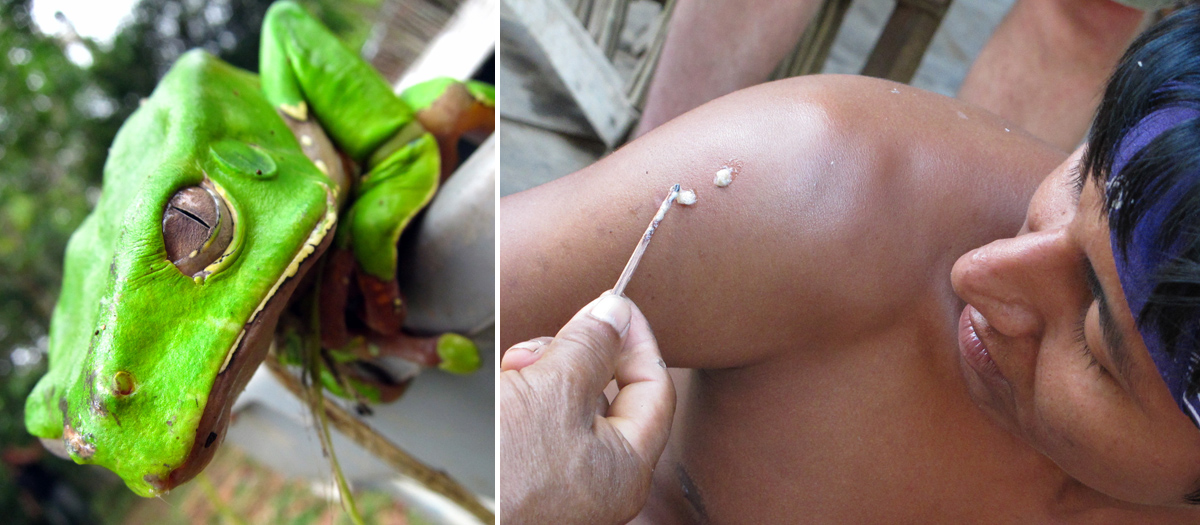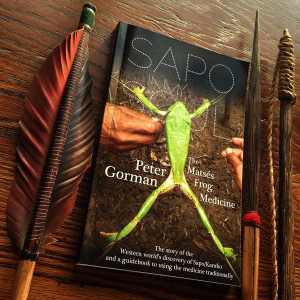
Sapo Ceremonies can be made part of an expedition, arranged on their own at Aucayacu Camp, or in Iquitos.
Please contact us to discuss any questions regarding Sapo and/or Ayahuasca Ceremonies and Dietas.
Known also as Kambo, dow kiet!, and Frog Sweat — Sapo is the secretion of the Phylomedusa bicolor tree frog.
“… At about 14 minutes you realize you’re not going to die and you find yourself cursing the person who gave you the medicine, screaming, or just laughing at being alive … And then you realize–maybe in an hour, maybe in three hours if you don’t have experience–that you are cleaner and stronger than you have ever been. You see and hear better than you have ever seen or heard. And that will last days to weeks, depending on your subsequent diet and such. And that’s why people utilize the medicine. Because it cleans them up, eliminates toxins stored in the body, in the pores, in the blood stream, in the kidney and liver, in your glands.”
– Peter Gorman, on the use and effects of Sapo
Further info:
Photos from Aucayacu River, Peru 2010 of the frog, and the process of collecting and applying the medicine.
http://www.flickr.com/photos/morganmaher/sets/72157627256576409/
Info and articles from Peter Gorman;
(Peter Gorman is a friend, and essentially the first Westerner to experience Sapo, and become involved in its collection for research purposes, studies, analysis, etc
http://thegormanblog.blogspot.com/2006/12/ahhh-frog-sweat.html
http://thegormanblog.blogspot.com/2010/01/matses-and-spiritual-beliefs.html
http://thegormanblog.blogspot.com/2010/01/more-matses-sapo-spirituality.html
http://www.pgorman.com/MakingMagic.htm
–
An article about a different tradition and indigenous groups than the Matses. Provides insights into this medicine from a different angle:
http://www.ayahuasca.com/spirit/kambo-the-spirit-of-the-shaman/
–
Pharmacological info:
“He identified the dow-kiet! as a phyllomedusa bicolor, a rare arboreal tree frog. The sapo, he said, is a sort of fantastic chemical cocktail with potential medical applications. “No other amphibian skin can compete with it,” he wrote. “Up to seven percent of sapo’s weight is in potently active peptides, easily absorbed through burned, inflamed areas of the skin.” He explained that among the several dozen peptides found insapo, seven were bioactive- which meant that each has an affinity and selectivity for binding with receptor sites in humans. (A receptor is like a lock that when opened with the right key–the bioactive peptides-triggers chemical reactions in the body.) The peptide families represented in the dow-kiet! include bradykinins, tachykinins, caerulein, sauvagine, tryptophyllins, dermorphins. and bombesins.
Based on the concentrations and functions of the peptides found in and extracted from the sapo sample I sent, Erspamer was able to account for all of the physical symptoms I described as sapo intoxication. On the peripheral effects. Erspamer repoited, “Caerulein and the equiactive phyllocaerulein display a potent action on the gastrointestinal smooth muscle and gastric and pancreatic secretions. . . . Side effects observed (in volunteer patients with post operative intestinal atony) were nausea, vomiting, facial flush, mild tachycardia (heart palpitations), changes in blood pressure, sweating, abdominal discomfort, and urge for defecation.”
Phyllomedusin, a new peptide of the tachykinin family, strongly affects the salivary glands, tear ducts, intestines, and bowels: and contributed to the violent purging I experienced. Sauvagine causes a long-lasting fall in blood pressure, accompanied by severe tachycardia and stimulation of the adrenal cortex, which contributed to the satiety, heightened sensory perception, and increased stamina I described. Phyllokinin, a new peptide of the bradykinin family, is a potent blood-vessel dilator and accounted for the intense rushing in my blood during the initial phase of sapo intoxication.
“It may be reasonably concluded, Erspamer wrote. “that the intense peripheral cardiovascular and gastrointestinal symptoms observed in the early phase of sapo intoxication may be entirely ascribed to the known bioactive peptides occurring in large amounts in the frog material.”
As to sapo’s central effects, he wrote, “increase in physical strength, enhanced resistance to hunger and thirst, and more generally, increase in the capacity to face stress situations may be explained by the presence of caerulein and sauvagine in the drug. Caerulein in humans produces “an analgesic effect . . . possibly related to release of beta-endorphins .. . in patients suffering from renal colic, rest pain due to peripheral vascular insufficiency (limited circulation), and even cancer pain.” Additionally, “It caused in human volunteers a significant reduction in hunger and food intake.

